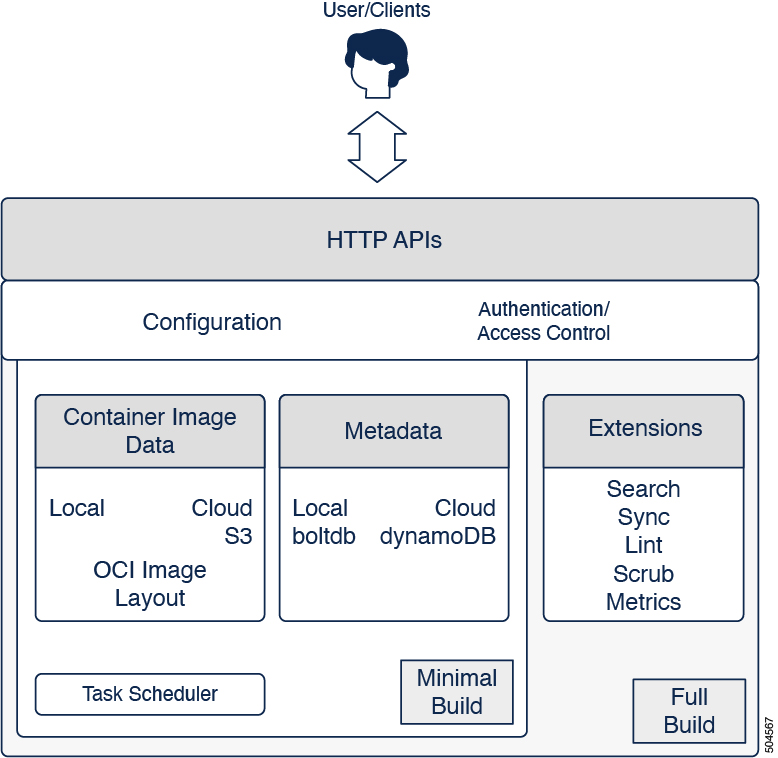Architecture¶
zot is an OCI-native container image registry. This document discusses the design goals, the overall architecture, and the design choices made in the implementation of the design goals.
Design Goals¶
OCI-first¶
-
HTTP APIs strictly conforms to the OCI Distribution Specification
zot intends to be a production reference implementation for the OCI Distribution Specification. In fact, zot does not support any other vendor protocol or specification.
-
Storage layout follows the OCI Image Specification
The default and only supported storage layout is the OCI Image Layout. The implications of this choice are that any OCI image layout can be served by zot and conversely, zot converts data on-the-wire into an OCI image layout.
Single binary model¶
zot is a single binary image with all features included so that deployment is extremely simple in various environments, including bare-metal, cloud, and embedded devices. Behavior is controlled by a single configuration file.
Enable Only What You Need¶
A clear separation exists between (1) the core OCI-compliant HTTP APIs and storage functionality, and (2) other add-on features modeled as extensions. The extension features can be selectively enabled both at build-time and run-time.
For more information, see "Conditional Builds" in zot's security posture document.
Overall Architecture¶
As shown in the following figure, the architecture of zot is organized as:
zot-full = zot-minimal + extensions

The minimal build is the core OCI-compliant registry functionality as described by the OCI Distribution Specification.
The full build adds features that are not a part of the Distribution Specification, but are allowed to be added as Extensions.
External Interaction¶
External interaction with zot consists of the following two types:
-
Client-initiated data or meta-data queries
-
Admin-initiated configuration
All client-side interaction occurs over HTTP APIs. The core data path queries are governed by the OCI Distribution Specification. All additional meta-data queries are handled based on the setting of the search extension:
-
If the
searchextension is enabled, enhanced registry searching and filtering is supported, using graphQL. A database is maintained by zot to efficiently answer complex queries on data stored in the database. -
If the
searchextension is not enabled, basic queries are supported using the core APIs. These queries are less efficient and search actual storage, which is limited in content.
Configuration¶
A single configuration file governs zot instance behavior. An exception can be made for security concerns, wherein configuration items containing sensitive credentials can be stored in separate files referenced by the main configuration file. Using separate files allows stricter permissions to be enforced on those files if stored locally. Also, modeling as external files allows for storing Kubernetes Secrets.
The configuration file is divided into sections for http, storage, log, and extension, governing the behavior of the respective components.
Authentication and Authorization¶
A robust set of authentication and authorization options are supported natively in zot. These controls are enforced before access is allowed into the storage layer.
For more information, see User Authentication and Authorization with zot.
Storage Driver Support¶
zot supports any modern local filesystem. Remote filesystems, such as AWS S3 or any AWS S3-compatible storage system, are supported. Additional driver support is planned in the roadmap.
Deduplication is supported for both local and remote filesystems, but deduplication requires a filesystem with hard-link support.
For more information, see Storage Planning with zot.
Security Scanning¶
zot integrates with the trivy security scanner to scan container images for vulnerabilities. The database is kept current by periodically downloading any vulnerability database updates at a configurable interval. The user remains agnostic of the actual scanner implementation, which may change over time.
Extensions¶
Additional registry features that are not a part of the Distribution Specification are added as Extensions.
Extension features of zot are available only with a full zot image. They are not supported in a minimal zot image.
For more information about zot's extensions, see Extensions.
Background Tasks¶
Several periodic tasks occur in the registry, such as garbage collection, sync mirroring, and scrubbing. A task scheduler handles these tasks in the background, taking care not to degrade or interrupt foreground tasks running in the context of HTTP APIs.